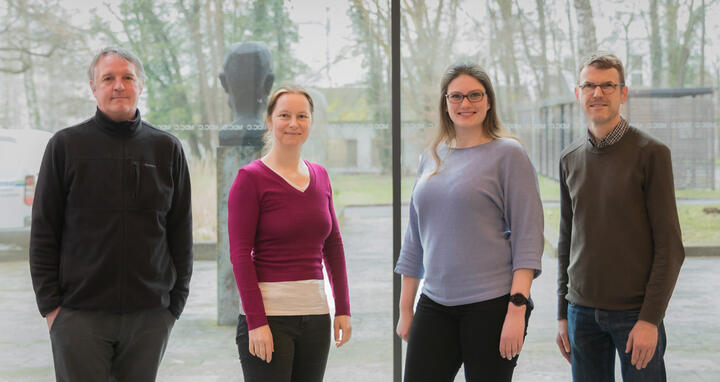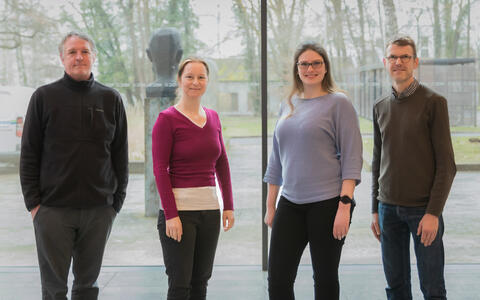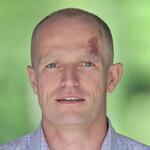Supporting innovation in biomedicine
It is not unusual for ten years or more to pass before scientific discoveries become marketable products that are used in patient care. The Max Delbrück Center’s Technology Transfer Office guides scientists down the long and winding road toward licensing agreements, industrial collaborations, and start-up formation, often helping them take critical steps toward marketability. The team of six organizes seminars on product development and patenting strategies, provides coaching and mentoring, helps find industry partners and funding opportunities, and takes the lead on patent and licensing administration. It works closely with the Technology Transfer Office of Charité – Universitätsmedizin Berlin and with Ascenion GmbH, an independent knowledge and technology transfer company.
The offerings of the Technology Transfer Office include two funding schemes. “Our BOOST scheme is an ideas competition with which we support early-stage projects,” explains Innovation and Technology Manager Dr. Daniel Romaker. Applications are open to Max Delbrück Center scientists whose ideas are still in the embryonic stage or require a proof of concept or feasibility study. The winners of the competition receive start-up funding of €40,000 over twelve months for materials and contracts. In addition, an external coach gives guidance on how to make product development more targeted.
Dr. Daniel Romaker, Dr. Beatrice Pöschel, Dr. Antonia Klein and Dr. Gerd Müller of the Technology Transfer Office
This year’s BOOST grants go to three researchers: Dr. Altuna Akalin, who leads the Bioinformatics and Omics Data Science Platform; Dr. Zsuzsanna Izsvák, who leads the Mobile DNA Lab; and Professor Kathrin de la Rosa, who leads the Cancer & Immunology/Immune Mechanisms and Human Antibodies Lab and who is working with her PhD student Clara Vázquez García to create a new vaccine development platform. Unfortunately, we cannot yet publicly reveal anything else about this project. The other two winning projects are presented here:
Dr. Altuna Akalin: Captain Kirk now uses ChatGPT
The system is designed to enable researchers to analyze their own data. And it should allow bioinformaticians to perform multiple analyses simultaneously, making them more efficient.
Even Captain Kirk spoke to the Starship Enterprise’s on-board computer when he wanted to know the coordinates of a star system or some other computation. Akalin now wants to make voice-controlled communication with computers possible for scientists as well. Based on GPT technology, he intends to develop a text-based dialogue system that serves as a user interface for analysis programs. GPT, which stands for “Generative Pre-trained Transformer,” is a state-of-the-art machine learning technology for large language models. “Programs for analyzing sequencing data are not very user-friendly,” the data scientist explains. “They tend to be difficult to use if you don’t have a computer science background.” He wants to create a chatbot that communicates with researchers, asking them such things as what samples are available and what exactly needs to be analyzed. The chatbot will guide them step by step through data analysis, and will also be linked to an open-ended data analysis tool. After the chatbot converts the researchers’ input into computer code, the program starts its calculations and once finished the system delivers the results. “Scientific research generates so much data that there simply aren’t enough bioinformaticians to analyze it all,” says Akalin. “The system is designed to enable researchers to analyze their own data. And it should allow bioinformaticians to perform multiple analyses simultaneously, making them more efficient.”
Dr. Zsuzsanna Izsvák: Steering genes into a safe harbor
The Sleeping Beauty transposon system can be used to insert DNA snippets into cellular DNA and is cheaper to produce than viral gene shuttles.
Izsvák invented the Sleeping Beauty technology in the late 1990s, and now wants to develop the tool further. Sleeping Beauty is an artificial transposon, a jumping gene that can change its position in the genome. Its ability to integrate into the genome can not only be used in gene transfer, such as to transfer a therapeutic gene into patient cells for gene therapies, but also in immunotherapies against cancer that work by boosting a patient’s own immune cells with an artificial receptor (known as a chimeric antigen receptor, CAR) so that they can better detect and fight tumor cells. Izsvák is also working on using Sleeping Beauty to treat age-related macular degeneration. A clinical trial testing this therapy is expected to begin later this year.
“The Sleeping Beauty transposon system can be used to insert DNA snippets into cellular DNA and is cheaper to produce than viral gene shuttles,” says Izsvák. “Plus, it’s safer and easier to handle, making it a real competitor to viral vectors.” In the BOOST project, the researcher wants to focus on making gene transfer safer. She is therefore looking for regions in the genome that are suitable for therapeutic gene insertion. In such a “safe harbor,” no other activities should be taking place to ensure that the host genes are not disrupted and that the therapeutic gene is well expressed. “This is a real challenge,” says the researcher. “Promoters, which are DNA sequences that regulate gene expression, are used to achieve good expression. These can overload the system, trigger stress responses, and completely change the cell’s transcriptome – a real biosafety concern.” To get around this problem, the researcher wants to create a sort of navigation aid that will help Sleeping Beauty reach a “safe harbor.”
Making the leap from lab to clinic
With its second funding scheme, Pre-GoBio, the Max Delbrück Center supports projects that have the potential to make the leap from the lab to the clinic. “Our basic researchers want to gain insights into the molecular mechanisms of health and disease,” says Romaker. “They don’t necessarily have a specific application in mind, but the overall goal of research at the Max Delbrück Center is to develop drugs and technologies that can help patients.” So the innovation and technology managers are on the lookout for projects that have a certain inherent value in the marketplace. “These are research findings that could help meet a medical need by offering, for example, the prospect of new therapeutic options for diseases that are currently untreatable or difficult to treat,” explains Romaker.
As with BOOST grants, the decision on who receives Pre-GoBio funding is made by a panel of experts to whom the applicants must make their research palatable through short talks. The panel then selects two projects that each receive €450,000 for up to three years. At the end of 18 months, the progress of the project is assessed to determine whether to continue with third-year funding. A workshop is held at the very end to evaluate the results of the entire project; a further €150,000 of funding may then be provided for an additional year. Two projects have been chosen for 2023: the first is led by Professor Markus Landthaler, head of the RNA Biology and Posttranscriptional Regulation Lab; and the second by Professor Gary Lewin, head of the Molecular Physiology of Somatic Sensation Lab.
Professor Markus Landthaler: The protein booster
Biopharmaceuticals, also known as biologics, are biotechnologically produced drugs that can be used to treat serious diseases like cancer, rheumatism, and multiple sclerosis. Their production is very complex, as they are often made from genetically engineered mammalian cells. Among the most commonly used host cell systems are Chinese hamster ovary (CHO) cells, which are an immortalized cell line derived from the ovaries of the Chinese hamster.
We succeeded in engineering the CHO cells so that they can produce more proteins of therapeutic interest.
“CHO cells have become a preferred choice for therapeutic protein production because they can be grown in large-scale, high-density cell cultures and can be genetically engineered relatively easily,” explains Landthaler. “They produce proteins reliably and effectively while remaining stable.” However, the process is extremely time- and labor-intensive. Landthaler had an idea for how to boost the production of these biologics. “We succeeded in engineering the CHO cells so that they can produce more proteins of therapeutic interest,” he says. To do this, the scientists made sure that a certain protein was expressed in the CHO cells, which in turn caused an increase in the production of the desired therapeutic proteins.
“This project is a prime example of successful institutional funding,” says Romaker. Landthaler used a BOOST grant to begin the first trials; a successful method for reprogramming the CHO cells was patented last year; and the Pre-GoBio funding is now helping to put the finishing touches on the technology. “If everything works as planned, the production capacity of CHO cells will be increased many times over,” says Romaker. “That would catapult biologic drug production to a whole new level. The pharmaceutical industry has been waiting for this for a long time.” In addition to the financial support from Pre-GoBio, Landthaler has been awarded a grant from the Helmholtz Initiative and Networking Fund that will enable him to test everything under industrial conditions and show that the method is also suitable for producing antibodies.
Professor Gary Lewin turns off the pain
If we succeed in blocking this ion channel, we could help patients who suffer from chronic pain.
Ion channels are proteins that form pores in the cell membranes through which electrically charged particles can pass. That’s why they are also called channel proteins. While studying melanoma cells, Lewin’s team discovered a previously unknown ion channel. In experiments with mouse models, two of the team members – Dr. Sampurna Chakrabarti and Dr. Alice Rossi – were able to show that this ion channel is largely responsible for the sensitivity of tactile and pain receptors. Together, they submitted the application for the project. “That means if we succeed in blocking this ion channel, we could help patients who suffer from chronic pain,” says Lewin. His team therefore plans to screen drugs in the hope of finding a molecule that turns off the ion channel and thus alleviates pain.
Networking, with or without pizza
The Technology Transfer Office not only provides scientists with guidance, advice, and funding – it also promotes networking and exchange among the Center’s researchers. A good example are the monthly “meet-and-eat” sessions that it organizes. “Before the coronavirus pandemic, we used to meet in person for pizza and networking,” Romaker’s colleague Dr. Antonia Klein recounts. “But at the moment, we’re still holding virtual meetings.” The scientists have to get the pizza themselves – but more people can take part.
Text: Jana Ehrhardt-Joswig











